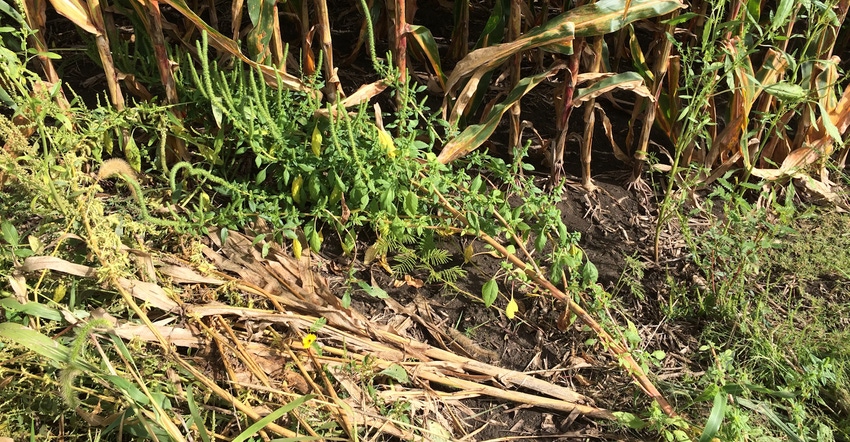January 12, 2017

By Meaghan Anderson and Bob Hartzler
Palmer amaranth is an aggressive, competitive summer annual weed native to the Southwest. This species caused devastating yield loss in Southeastern soybean, cotton and corn production, and has now been discovered in nearly every Midwestern state, including Iowa. Palmer amaranth is a close relative to redroot pigweed, smooth pigweed and waterhemp.
Since 2013, five counties were known to be infested with Palmer. All infestations were related to traditional agriculture practices. In 2016, two new discoveries in newly seeded conservation plantings began a whirlwind summer of new Palmer amaranth discoveries across the state.
Palmer has now been identified in over 40 Iowa counties. While new discoveries are slowing for the season, it’s not too late to be scouting for this invader in high-risk areas, which include animal ag operations that may import feed or bedding from Southern states, high-traffic areas in fields, farms with equipment from Southern states and newly seeded conservation plantings.
How did Palmer amaranth get in conservation plantings?
Unfortunately, it appears many of the native seed mixes used in the conservation plantings were contaminated with Palmer amaranth.
How is Palmer amaranth different from waterhemp?
Like waterhemp, this species is highly variable in appearance, competes well with corn and soybeans, is resistant to many herbicides, and has a long emergence pattern, making full-season control difficult. Both species produce significant seed each year, sometimes as many as 500,000 to 1 million seed per female plant. Palmer amaranth can grow as fast as 2 to 3 inches per day, is more competitive, and thus can cause significantly more yield loss than waterhemp.
This weed is a great concern, given the current difficulty in managing waterhemp in crop fields. Failure to achieve control can result in complete crop failures. One small Iowa soybean field with an infestation identified in 2013 was mowed this year due to a Palmer control failure.
Identifying Palmer
Similarities between waterhemp and Palmer amaranth early in the growing season can make identifying the new weed difficult prior to flowering. One fairly consistent vegetative characteristic is that Palmer amaranth leaves have a petiole (leaf stalk) that is as long, or longer, than the leaf blade itself. Palmer is dioecious, meaning it has separate male and female plants. Flowers from a female plant are necessary to confirm its identity. Female plants will produce inflorescences (seed heads) that are sharp to the touch due to the large bracts surrounding individual flowers. These sharp bracts should remain visible even this late in the year, giving the seedhead a spikey appearance.
Even after crop fields are harvested, Palmer can still be identified in other areas and noted for management next year. That management will differ depending on the area it’s infesting.
While mowing can be effective, it is too late now to be of any benefit. Palmer seed will be mature, thus seed production will not be reduced with mowing at this time. An even better reason to stop mowing is the likelihood of equipment transporting seed outside of the infested field. The primary concern with the Palmer in conservation plantings is that the weed will move into adjacent crop fields where it is better adapted for survival. The focus now should be to minimize the threat of seed movement out of infested areas. Avoid mowing and minimize traffic through infested areas.
In crop fields, Palmer can be controlled with the same programs used against waterhemp. For newly infested fields, adopting a zero-threshold approach where the goal is to prevent seed production can lead to eradication of the weed.
Conservation plantings
Next year, regular mowing should be used to reduce the productivity of returning Palmer in conservation plantings. Mowing is unlikely to kill plants, but it’s believed to be an efficient method of reducing seed production when hand removal of plants is not practical. Hand removal is the most effective control, but will likely not be practical if plants produced seed this year.
A common myth is that Palmer will go completely uncontrolled because it is resistant to everything. While this is a highly competitive and difficult to control weed, it’s not resistant to everything. Unfortunately, we know very little about the resistance profile of Palmer amaranth populations coming into Iowa.
Like waterhemp, Palmer can develop herbicide resistance. Both species have biotypes resistant to herbicide groups HG 2, HG 5, HG 9, HG 14 and HG 27. Palmer has biotypes resistant to the HG 3 active ingredients, like trifluralin and pendimethalin. Waterhemp has ones resistant to the HG 4 active ingredient 2,4-D. Most populations from crop fields are resistant to more than one group.
In crop fields, farmers should begin with a strong residual program to manage Palmer and consider incorporating another residual herbicide into their postemergence herbicide application. Undoubtedly, some Palmer will escape these management tactics. Hand removal of those surviving plants will be worth the effort. In future years, use of different herbicide groups (sites of action) and full herbicide rates will help delay resistance development in these populations.
- Anderson is a field agronomist in east-central Iowa and Hartzler is a weed management specialist at Ames, both with ISU Extension.
You May Also Like




